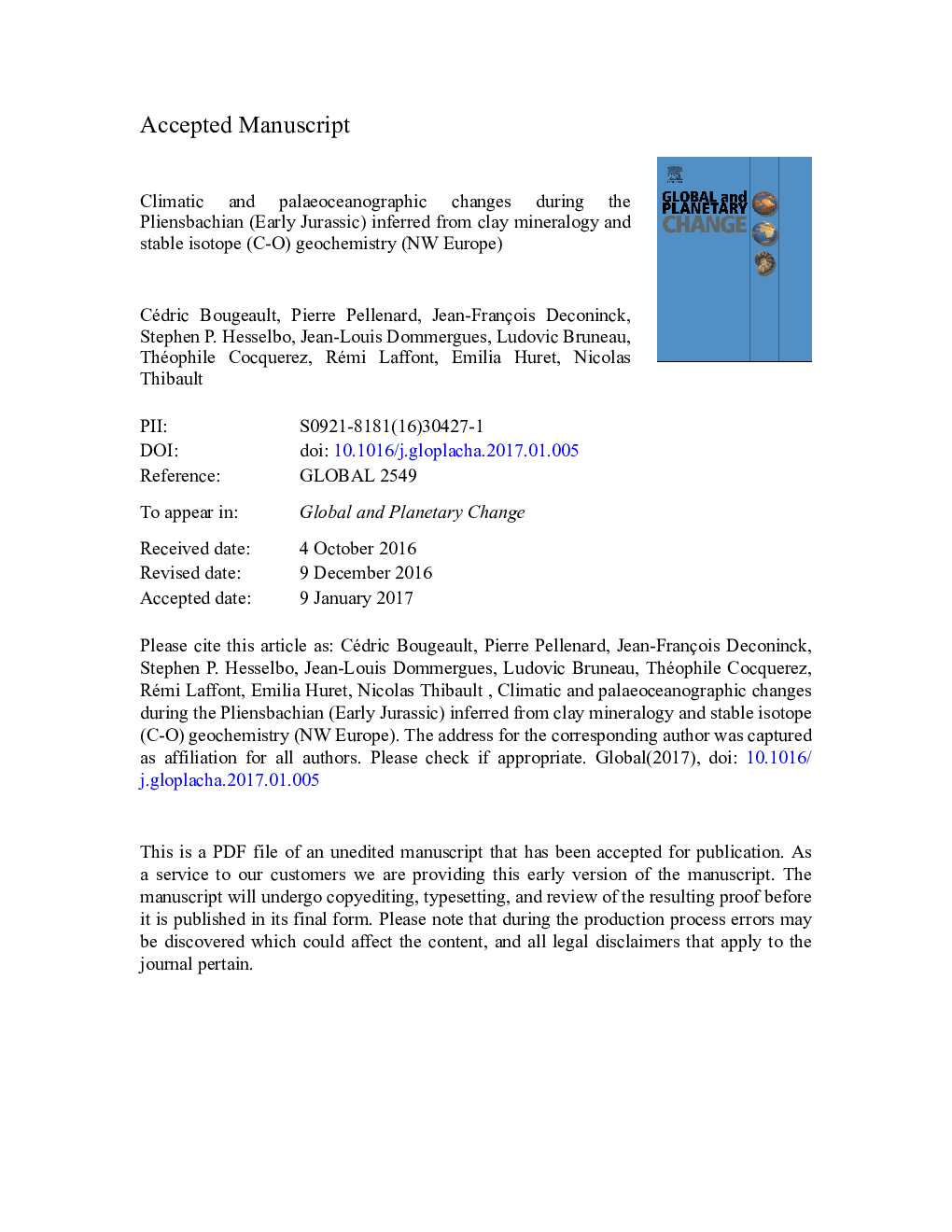| کد مقاله | کد نشریه | سال انتشار | مقاله انگلیسی | نسخه تمام متن |
|---|---|---|---|---|
| 5755301 | 1621633 | 2017 | 60 صفحه PDF | دانلود رایگان |
عنوان انگلیسی مقاله ISI
Climatic and palaeoceanographic changes during the Pliensbachian (Early Jurassic) inferred from clay mineralogy and stable isotope (C-O) geochemistry (NW Europe)
دانلود مقاله + سفارش ترجمه
دانلود مقاله ISI انگلیسی
رایگان برای ایرانیان
کلمات کلیدی
موضوعات مرتبط
مهندسی و علوم پایه
علوم زمین و سیارات
فرآیندهای سطح زمین
پیش نمایش صفحه اول مقاله

چکیده انگلیسی
The Early Jurassic was broadly a greenhouse climate period that was punctuated by short warm and cold climatic events, positive and negative excursions of carbon isotopes, and episodes of enhanced organic matter burial. Clay minerals from Pliensbachian sediments recovered from two boreholes in the Paris Basin, are used here as proxies of detrital supplies, runoff conditions, and palaeoceanographic changes. The combined use of these minerals with stable isotope data (C-O) from bulk carbonates and organic matter allows palaeoclimatic reconstructions to be refined for the Pliensbachian. Kaolinite/illite ratio is discussed as a reliable proxy of the hydrological cycle and runoff from landmasses. Three periods of enhanced runoff are recognised within the Pliensbachian. The first one at the Sinemurian-Pliensbachian transition shows a significant increase of kaolinite concomitant with the negative carbon isotope excursion at the so-called Sinemurian Pliensbachian Boundary Event (SPBE). The Early/Late Pliensbachian transition was also characterised by more humid conditions. This warm interval is associated with a major change in oceanic circulation during the Davoei Zone, likely triggered by sea-level rise; the newly created palaeogeography, notably the flooding of the London-Brabant Massif, allowed boreal detrital supplies, including kaolinite and chlorite, to be exported to the Paris Basin. The last event of enhanced runoff occurred during the late Pliensbachian (Subnodosus Subzone of the Margaritatus Zone), which occurred also during a warm period, favouring organic matter production and preservation. Our study highlights the major role of the London Brabant Massif in influencing oceanic circulation of the NW European area, as a topographic barrier (emerged lands) during periods of lowstand sea-level and its flooding during period of high sea-level. This massif was the unique source of smectite in the Paris Basin. Two episodes of smectite-rich sedimentation ('smectite events'), coincide with regressive intervals, indicating emersion of the London Brabant Massif and thus suggesting that an amplitude of sea-level change high enough to be linked to glacio-eustasy. This mechanism is consistent with sedimentological and geochemical evidences of continental ice growth notably during the Latest Pliensbachian (Spinatum Zone), and possibly during the Early Pliensbachian (late Jamesoni/early Ibex Zones).
ناشر
Database: Elsevier - ScienceDirect (ساینس دایرکت)
Journal: Global and Planetary Change - Volume 149, February 2017, Pages 139-152
Journal: Global and Planetary Change - Volume 149, February 2017, Pages 139-152
نویسندگان
Cédric Bougeault, Pierre Pellenard, Jean-François Deconinck, Stephen P. Hesselbo, Jean-Louis Dommergues, Ludovic Bruneau, Théophile Cocquerez, Rémi Laffont, Emilia Huret, Nicolas Thibault,